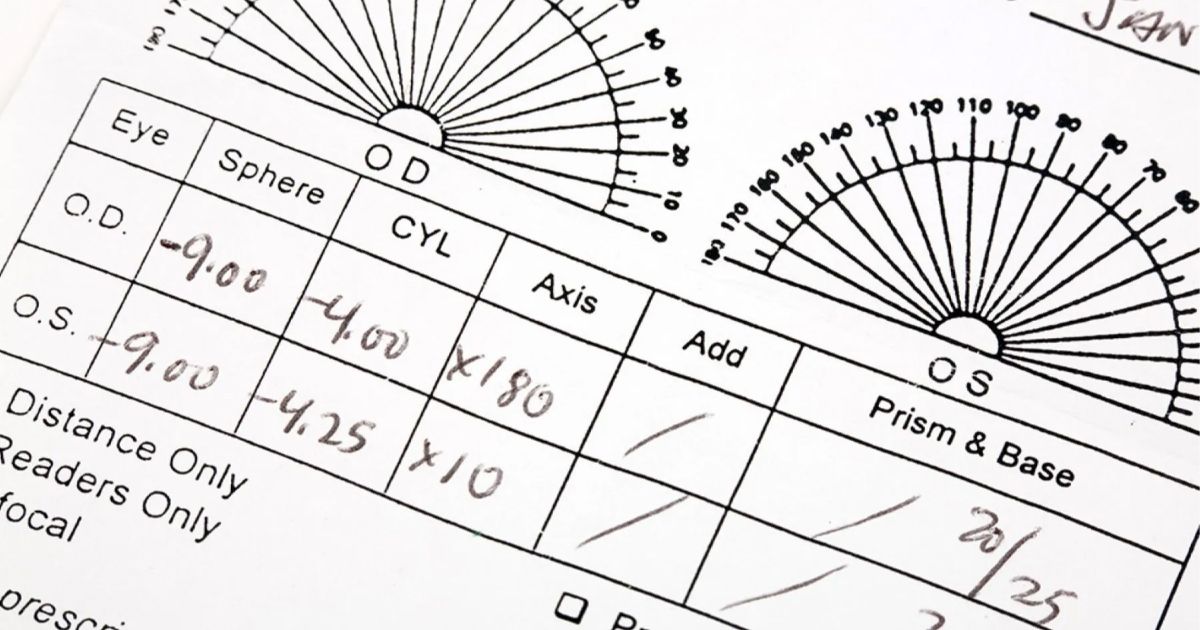Decoding Your Vision Prescription: A Guide to Understanding Your Eye Doctor's Orders

Read time: 4 minutes
For those with vision impairment, a vision prescription is a lifeline to clarity, and understanding how to read it is crucial for obtaining the right eyewear. Whether you're new to glasses or contact lenses, or simply renewing your prescription, deciphering the intricacies of your vision prescription is the first step towards achieving optimal vision correction. In this comprehensive guide, we will walk you through the various components of a vision prescription and delve into the additional measurements that are essential for achieving perfect glasses or contact lenses.
Components of a Vision Prescription
A vision prescription typically comprises several components, each with a specific role in guiding eyewear professionals to craft lenses tailored to your unique visual needs. Here's a detailed breakdown of the key components:
O.D. and O.S.
- O.D. stands for "oculus dexter," denoting your right eye.
- O.S. stands for "oculus sinister," representing your left eye.
These components are essential for specifying the prescription for each eye individually, as visual needs may differ between your right and left eyes. For each eye, you will typically find the following values:
- Sphere (SPH): This indicates the level of nearsightedness (-) or farsightedness (+). The number may be preceded by a plus or minus sign, such as -2.00 or +1.50.
- Cylinder (CYL): If you have astigmatism, the CYL value signifies the extent of distortion in your vision.
- Axis: The axis, represented in degrees ranging from 0 to 180, tells you the orientation of the cylinder. It is a critical component for astigmatism correction.
- Add: This value is an additional power that is used for reading or multifocal prescriptions, typically indicated for people who require reading glasses.
Pupillary Distance (PD)
The pupillary distance, or PD, is the measurement between the centers of your pupils. It is a vital measurement for both glasses and contact lenses as it ensures that the optical centers of the lenses align with your pupils.
Base Curve and Diameter (for Contact Lenses)
If you are considering contact lenses, your prescription will include information about the base curve and diameter. The base curve refers to the curvature of the lens, while the diameter specifies the size of the lens. These values are critical for ensuring that your contact lenses fit comfortably and correctly on your eyes.
How to Interpret Your Prescription
To interpret your prescription effectively, it is essential to understand that the SPH value is the primary prescription for distance vision. If you have astigmatism, the CYL and Axis values are provided to correct it, while the ADD value, if present, is the amount of magnification needed for optimal near vision clarity.
For example, if your prescription reads as follows:
- O.D. SPH: -4.00
- O.S. SPH: -1.50, CYL: -1.25, Axis: 180
- ADD: +2.00
This means that your right eye (O.D.) has moderate nearsightedness and has no astigmatism, while your left eye (O.S.) has mild nearsightedness and does have an astigmatism. The ADD value indicates that you require reading or multifocal glasses.
Additional Measurements for Glasses and Contacts
In addition to your prescription, several other crucial measurements are necessary to ensure that your glasses or contact lenses provide optimal vision correction and comfort:
Frame Measurements (for Glasses)
- Frame Width: The frame width should be proportionate to your face size, ensuring that it complements your facial features.
- Bridge Width: The bridge width measurement is crucial for ensuring that the frame's bridge fits comfortably on your nose.
- Temple Length: The temple length measurement ensures that the temple arms extend to the right length behind your ears, providing a secure and comfortable fit.
Lens Type and Material (for Glasses)
Your optician will assist you in selecting the most suitable lens type (single vision, bifocal, progressive), material (plastic, polycarbonate, high-index), and coatings (anti-reflective, UV protection) based on your prescription and lifestyle. These choices are critical for achieving the best visual experience.
Contact Lens Prescription Details (for Contacts)
When it comes to contact lenses, your eye care professional will take precise measurements of your cornea's curvature and diameter to ensure a proper fit. This is especially important for contact lens wearers to avoid discomfort, eye irritation, and potential complications. Learn more about what a contact lens fitting involves.
The Takeaway
Understanding how to read your vision prescription is the initial step toward obtaining the perfect glasses or contact lenses. Remember that it's not just the prescription components that matter; the additional measurements for fit and comfort are equally important. Consulting with a qualified eye care professional is essential for achieving a precise fit and optimal vision correction. With an accurate examination & prescription, measurements, lenses, and frame selection, you'll be well on your way to experiencing the world with unmatched clarity and comfort.
Share this blog post on social or with a friend:
The information provided in this article is intended for general knowledge and educational purposes only and should not be construed as medical advice. It is strongly recommended to consult with an eye care professional for personalized recommendations and guidance regarding your individual needs and eye health concerns.
All of Urban Optiks Optometry's blog posts and articles contain information carefully curated from openly sourced materials available in the public domain. We strive to ensure the accuracy and relevance of the information provided. For a comprehensive understanding of our practices and to read our full disclosure statement, please click here.


















